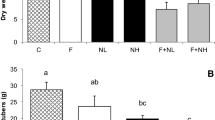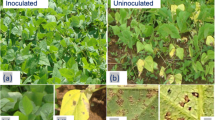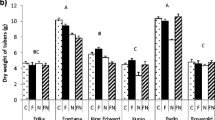Abstract
The effects of soil moisture (varying from 15% to 42% (v/v)) and sowing depth (1.5–6.0 cm) on the development of bean plants grown in sterile soil infested by the pathogen Rhizoctonia solani and its antagonist Trichoderma harzianum were studied under greenhouse conditions. The four possible combinations of soil infestation with both fungi were tested. Disease severity, percentage of plants emerged, plant height and dry weight were evaluated 3 weeks after sowing. Emergence rate and growth of plants inoculated only with R. solani were not affected by soil moisture, but in the presence of both fungi, plant emergence, plant height and dry weight significantly decreased when soil moisture diminished. Deep sowing significantly reduced the emergence rate and growth of those plants that were inoculated with R. solani only. However, when the soil was infested with both fungi, the effect of sowing depth was not significant. At a sowing depth of 6.0 cm, the percentage of plants emerged was 50% in the presence of T. harzianum, but only 6.7% when the pathogen was inoculated alone. The antagonist protected bean seedlings from pre-emergence damping-off, reduced disease severity and increased plant growth in the presence of R. solani, especially in moist soil.




Similar content being viewed by others
References
Abawi, G. S., & Pastor-Corrales, M. A. (1990). Root rots of beans in Latin America and Africa: Diagnosis, research methodologies, and management strategies. Cali: CIAT.
Adams, B. P. (1990). The potential of mycoparasites for biological control of plant diseases. Annual Review of Phytopathology, 28, 59–72.
Canaday, C. H. (1998). Differences in the incidence of Rhizoctonia root rot of snap bean associated with different potash fertilizers. Phytopathology, 88, S124.
Chet, I., Elad, Y., Kalfon, A., Hadar, Y., & Katan, J. (1982). Integrated control of soil-borne and bulb-borne pathogens in iris. Phytoparasitica, 10, 229–236.
Crossan, D. F. (1965). Field and greenhouse experiments for control of Rhizoctonia root rot of snapbean. Phytopathology, 55, 503.
Dorrance, A. E., Kleinhenz, M. D., McClure, S. A., & Tuttle, N. T. (2003). Temperature, moisture, and seed treatment effects on Rhizoctonia solani root rot of soybean. Plant Disease, 87, 533–538.
Elad, Y., Chet, I., & Katan, J. (1980). Trichoderma harzianum: A biocontrol agent effective against Sclerotium rolfsii and Rhizoctonia solani. Phytopathology, 70, 119–121.
Fenille, R. C., & Sousa, N. L. (1999). Efeitos de materiais orgânicos e da umidade do solo na patogenicidade de Rhizoctonia solani Kühn GA-4 HGI ao feijoeiro. Pesquisa Agropecuária Brasileira, 34, 1959–1967.
Galindo, J. J., Abawi, G. S., & Thurston, H. D. (1982). Variability among isolates of Rhizoctonia solani associated with snap bean hypocotyls and soils in New York. Plant Disease, 66, 390–394.
Hadar, Y., Chet, I., & Henis, Y. (1979). Biological control of Rhizoctonia solani damping-off with wheat bran culture of Trichoderma harzianum. Phytopathology, 69, 64–68.
Hall, R. (1991). Compendium of bean diseases. St. Paul: APS Press.
Huissman, O. C. (1988). Colonization of field-grown cotton roots by pathogenic and saprophytic soilborne fungi. Phytopathology, 78, 716–722.
Klein, D., & Eveleigh, D. E. (1998). Ecology of Trichoderma. In C. P. Kubicek, & G. E. Harman (Eds.), Trichoderma & Gliocladium – Enzymes, biological control and commercial applications (Vol. 1, pp. 57–74). London: Taylor & Francis Ltd.
Kobriger, K. M., & Hagedorn, D. J. (1983). Determination of bean root rot potential in vegetable production fields of Wisconsin’s Central Sands. Plant Disease, 67, 177–178.
Kumar, S., Sivasithamparam, K., Gill, J. S., & Sweetingham, M. W. (1999). Temperature and water potential effects on growth and pathogenicity of Rhizoctonia solani to lupin. Canadian Journal of Microbiology, 45, 389–395.
Leach, L. D., & Garber, R. H. (1970). Control of Rhizoctonia. In J. R. Parmeter Jr. (Eds.), Rhizoctonia solani: Biology and pathology (pp. 189–199). Berkeley: University of California Press.
Lewis, J. A., & Papavizas, G. C. (1977). Factors affecting Rhizoctonia solani infection of soybeans in the greenhouse. Plant Disease Reporter, 61, 196–200.
Lewis, J. A., & Papavizas, G. C. (1980). Integrated control of Rhizoctonia fruit rot of cucumber. Phytopathology, 70, 85–89.
Liu, S., & Baker, R. (1980). Mechanism of biological control in soil suppressive to Rhizoctonia solani. Phytopathology, 70, 404–412.
Manning, W. J., Crossan, D. F., & Morton, D. J. (1967). Effects of planting depth and asphalt mulch on Rhizoctonia root and hypocotyl rot of snapbean. Plant Disease Reporter, 51, 158–160.
Paula Júnior, T. J. (2002). Integrated management of bean Rhizoctonia root rot. PhD thesis, University of Hanover, Hanover, Germany.
Ploetz, R. C., & Mitchell, D. J. (1985). Influence of water potential on the survival and saprophytic activity of Rhizoctonia solani, AG-4 in natural soil. Canadian Journal of Botany, 63, 2364–2368.
Rosa, S. D. V. (1990). Efeitos das profundidades de semeadura e do molhamento do solo sobre o estabelecimento do estande e desenvolvimento da cultura do feijão (Phaseolus vulgaris L.). MSc Thesis, ESALQ, Piracicaba, Brazil.
Shehata, M. A., Davis, D. W., & Anderson, N. A. (1984). Resistance to Rhizoctonia stem rot in peas as influenced by temperature, watering method, and period of disease development. Plant Disease, 68, 22–24.
Silbernagel, M. J. (1981). Effects of cultural practices on root rot in snap beans. Phytopathology, 71, 254.
Sweetingham, M. W. (1996). Integrated control of Rhizoctonia species. In B. Sneh, S. Jabaji-Hare, S. Neate, & G. Dijst (Eds.), Rhizoctonia species: Taxonomy, molecular biology, ecology, pathology and disease control (pp. 549–558). Dordrecht, The Netherlands: Kluwer Academic Publishers.
Teo, B. K., Yitbarek, S. M., Verma, P. R., & Morrall, R. A. A. (1988). Influence of soil moisture, seeding date and Rhizoctonia solani isolates (AG 2-1 and AG 4) on disease incidence and yield in canola. Canadian Journal of Plant Pathology, 10, 151–158.
Van Bruggen, A. H. C., Whalen, A. H., & Arneson, P. A. (1986). Emergence, growth, and development of dry bean seedlings in response to temperature, soil moisture, and Rhizoctonia solani. Phytopathology, 76, 568–572.
Van Schoonhoven, A., & Pastor-Corrales, M. A. (1987). Standard system for the evaluation of bean germplasm. Cali: CIAT.
Vieira, R. F., & Paula Júnior, T. J. (2006). Semente: veículo de disseminação de patógenos. In C. Vieira, T. J. Paula Júnior, & A. Borém (Eds.), Feijão (pp. 437–476). Viçosa, Brazil: Ed. UFV.
Wester, R. E., & Goth, R. W. (1965). Pathogenicity of Rhizoctonia solani on lima bean seedlings. Phytopathology, 55, 506.
Author information
Authors and Affiliations
Corresponding author
Rights and permissions
About this article
Cite this article
Paula Júnior, T.J., Rotter, C. & Hau, B. Effects of soil moisture and sowing depth on the development of bean plants grown in sterile soil infested by Rhizoctonia solani and Trichoderma harzianum . Eur J Plant Pathol 119, 193–202 (2007). https://doi.org/10.1007/s10658-007-9161-5
Received:
Accepted:
Published:
Issue Date:
DOI: https://doi.org/10.1007/s10658-007-9161-5




